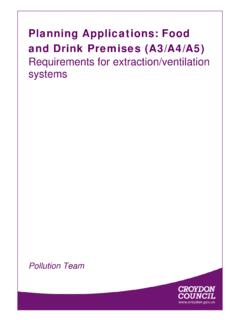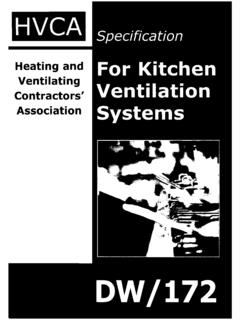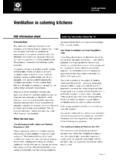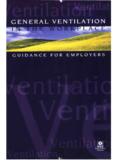Transcription of Controlling construction dust with on-tool extraction CIS69
1 1 of 4 pagesHealth and Safety ExecutiveHealth and Safety ExecutiveConstruction Information Sheet No 69 HSE information sheetControlling construction dust with on-tool extractionIntroductionThis information sheet gives guidance on choosing, using and maintaining on-tool extraction for Controlling construction dust. It is mainly for managers and supervisors but is also useful for trade union safety representatives and hazards posed by construction dustRegularly breathing construction dust can cause diseases like lung cancer, asthma, chronic obstructive pulmonary disease (COPD which includes emphysema and other breathing difficulties) and silicosis. Silica is the second biggest killer of construction workers after Some of the most common construction jobs create high dust levels.
2 These jobs often involve the use of power tools like cut-off saws, grinders, breakers and sanders. There is a legal duty for employers2 to prevent or adequately control worker exposure to construction dust. on-tool extraction is an effective control for this dust and will reduce the risk of ill health. How to choose on-tool extractionOn-tool extraction is a type of local exhaust ventilation (LEV) system which is fitted directly onto the tool. The system consists of several individual parts the tool, captor hood, extraction unit and tubing. Each part plays a role in establishing how effective the system is and the level of control it gives. Manufacturers/suppliers do provide complete systems but some parts (especially extraction units) can be used with other tool makes and is important to choose parts that are compatible and work together.
3 The dust may be poorly controlled if you do not. Make sure the system is right for the particular task(s) and the method(s) of work. Involve workers in the selection process. Use the following guidelines:Tools and accessoriesLimit the amount of dust created by choosing appropriate tools and accessories eg sanding blocks/pads or grinding discs with enough holes to allow the dust to be extracted through them (see Figure 1).Figure 1 Tools and accessories providing for effective dust removal Captor hood The hood is the most important part of the LEV system. It is often manufactured as part of the power tool but it can also be retro-fitted to existing equipment. See Figure 2 for of 4 pagesControlling construction dust with on-tool extractionHealth and Safety ExecutiveWhat it doesThe hood captures the dust as it is produced.
4 How to choose the right onePoor design or damage to the hood will significantly affect the control of dust. Check that the hood: is designed for the tool and the work that you are going to do (seek guidance on this from the manufacturer or supplier); sits as closely as possible to the work surface when in use dust will escape through any gaps between the two; is easy to use and does not interfere with the work 2 Examples of captor hoods on a grinder and breakerExtraction unitThe extraction unit is like an industrial vacuum. It is a portable unit and also an important part of the LEV system (see Figure 3). What it doesThe extraction unit removes the dust from the captor hood, filters it and then stores it for safe disposal. Selecting the correct extraction unit is key to achieving this 3 Examples of different extraction units How to choose the right oneYou can use extraction units interchangeably on some tools but the specification of the unit must be suitable for the tool and the task: Choose an H (High) or M (Medium) class These units provide effective and reliable extraction capability and are fitted with low-flow indicators.
5 The units are marked with a special label (see Figure 4). Don t just use a HEPA filter in a general commercial vacuum. (Note: An L (Low) class unit is only suitable for lower-toxicity dusts like gypsum in plasterboard.) Check that the unit creates and maintains enough air suction to cope with the amount of dust the work will create (manufacturers/suppliers can advise). It needs to remove the dust as fast as it is created. Lots of fine dust can quickly clog filters. Choose units with pre-filters, built-in back-flushing filter cleaning mechanisms or similar devices. Think how often the unit will need emptying. Check the waste capacity is right for the of 4 pagesControlling construction dust with on-tool extractionHealth and Safety ExecutiveFigure 4 Examples of labels on H and M class extraction units TubingWhat it doesThe tubing connects the captor hood to the extraction unit.
6 How to choose the right oneCheck that the tubing: is the right constuction, diameter and length for the work and the extraction unit; fits securely to both hood and unit. How to use on-tool extraction correctlyJust providing the right equipment is not enough to control dust risks. The equipment needs to be operated correctly and be properly maintained. That means you should pay particular attention to the following stages:Before useProvide trainingWorkers need the right training before using on-tool extraction . This includes information on: selecting the right on-tool system; pre-use checks and maintenance; how to use the system correctly; other controls that may be needed (eg respiratory protective equipment) and how to use them; common faults, how to spot them and the action to take; what to do if there is a problem.
7 During useFollow instructions on useMake sure you apply the system to the work in the correct way. Focus on: checking it is in good working order (not damaged) before work starts; following the method of work; using the equipment in the right way. Follow manufacturer s instructions; ensuring the captor hood is as close as possible to the work surface; ensuring the tubing has a good connection to both the captor hood and extraction unit. Use an adaptor if needed, not tape; emptying the extraction unit regularly. Use the correct disposable waste bags. Seal and place in the right waste container. Do not empty these bags to recycle them; cleaning the equipment regularly (eg wipe down daily). Do not let dust build up on working to maintain on-tool extractionRegular checks/maintenanceEnsure that the system works properly first time, every time.
8 Carry out formal maintenance checks at least once a week. You may have to do this more frequently if there is a high risk of the equipment being damaged. Concentrate on: damage to parts of the system such as the hood or ducting. Repair or replace straight away; maintaining the extraction unit s flow of air. Follow the manufacturer s instructions. Check that the airflow indicator and any built-in cleaning mechanism work properly. Replace filters when needed; replacing worn cutting discs examination and test (TExT)Equipment also needs proper servicing and testing to make sure that it remains effective over a long period. A TExT is a detailed and systematic examination that ensures the equipment can continue to perform as intended by its design. A person with the right knowledge, capabilities and experience should carry out a TExT at least every 14 months.
9 You might need more frequent testing if regular wear and tear could limit the effectiveness of the system more you own an on-tool extraction system you will need to arrange for this examination and keep a suitable record to show that it has been done. If you are hiring 4 of 4 pagesControlling construction dust with on-tool extractionHealth and Safety ExecutivePublished by the Health and Safety Executive CIS69 06/13 equipment, check with the hire company whether it has been appropriately tested with the hire company. Further advice is provided elsewhere by HSE on these ,5 Other important issuesThere are a number of other important issues relevant to users of on-tool extraction . These include: the risks linked to the dusts involved; other controls needed for these risks; guarding dangerous parts of the equipment; electrical safety and fire or explosion risks; lifting and carrying the equipment; working at height with the equipment; slips and trips from trailing cables.
10 Follow the advice given elsewhere by HSE on these toolsThe general principles of the above standards also apply to cordless tools with integrated filtered extraction devices. These units do not fall under the H (High), M (Medium) or L (Low) (filter) unit classification system. References1 Control of substances hazardous to health (Fifth edition). The Control of Substances Hazardous to Health Regulations 2002. Approved Code of Practice and guidance L5 (Fifth edition) HSE Books 2005 ISBN 978 0 7176 2981 7 BS EN 60335-2-69:2009 Household and similar electrical appliances. Safety. Part 2-69: Particular requirements for wet and dry vacuum cleaners, including power brush, for commercial use British Standards Institution 4 Controlling airborne contaminants at work: A guide to local exhaust ventilation (LEV) HSG258 (Second edition) HSE Books 2011 ISBN 978 0 7176 6415 3 Are you a supplier, importer or hirer of equipment?














